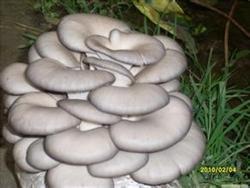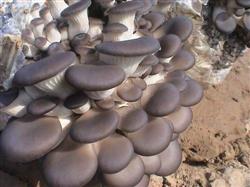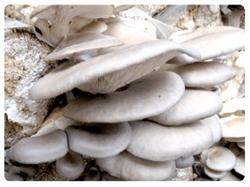Common problems and Solutions of Pleurotus ostreatus in the stage of growing bacteria

By visiting demonstration households and mushroom farmers, the following experiences are summarized. First, the hyphae do not germinate and do not eat food. Causes: material deterioration, breeding a large number of miscellaneous bacteria; culture material water content is too high or too low; bacteria aging, weak vitality; environmental temperature is too high or too low, excessive lime, pH value is on the high side. Solution: use fresh and mildew-free raw materials; use appropriate age bacteria (bacteria age 30-35 days); grasp suitable water content and hold water droplets between fingers for the degree of non-dripping; during the sterilization period, the greenhouse temperature should be kept at about 20 ℃, the material temperature should be about 25 ℃, the temperature should be slightly lower, not too high, strictly prevent burning bacteria. An appropriate amount of lime should be added to the culture material, especially when the temperature is low, the amount should not exceed 1% of the temperature PH7-8. Second, the culture material is sour. Causes: during the period of high temperature, there is no timely cooling and cooling, a large number of bacteria multiply, the material fermentation becomes sour, rotten and smelly; too much water in the material, insufficient air, anaerobic fermentation leads to material decay and odor. Solution: pour out the material, spread out and air, add appropriate amount of new material to continue fermentation, re-bag inoculation; if the material has rotted and blackened, it can only be discarded as fertilizer. Third, mycelium atrophy. The cause: the bag stacking is too high, the fermentation did not pour the stack in time to dissipate heat, the material temperature rose to more than 35 ℃ and destroyed the mycelium; the bag was too large, and the temperature was too high to pass through [Weibo] bad wind; the material was too wet to fill, and the air permeability was not good, and the mycelium atrophy phenomenon would occur due to anoxia. Solution: improve the environment of the inoculation site, pay attention to ventilation and cooling; stack bacteria in the bag, when the temperature is high, stack 2-4 layers, showing a "well" shape cross discharge, easy to dissipate heat; timely stacking and heat dissipation during the heat release period of the bag fermentation; grasp the material-water ratio when mixing, and make it loose and tight when bagging; the width of the film tube selected for bagging should not exceed 25cm to avoid excessive fermentation heat. Fourth, the wall of the bag is covered with bean dregs-like moss. The cause of occurrence: the culture material has high water content and poor air permeability, which leads to the breeding of a large number of yeasts, a large amount of accumulation on the bag film, and the fermentation sour taste appears in the material. Solution: use a round stick with a diameter of 1 cm to pierce 2-3 holes in the middle of the bag, 5-8 cm deep, to ventilate and replenish oxygen. soon, the yeast moss attached to the inner wall of the bag will gradually disappear and the mycelium of Pleurotus ostreatus will continue to grow. Fifth, mold pollution. Reason: the culture material or strain itself carries bacteria; the sanitary condition of the fungus site is poor or the old mushroom house is not thoroughly disinfected; the mushroom shed is high temperature, high humidity and no ventilation. Solution: select fresh, non-mildew, sun-exposed culture materials, fermentation should be thorough; avoid sowing in high temperature, strengthen ventilation, prevent damp and stuffy heat; select high-quality, mildew-resistant, fast-eating bacteria; mold pollution is found early, the area is small, can use lime water above pH=10 into the contaminated culture materials, at the same time move out of the bacteria field, separate bacteria management. If the pollution is serious, it will be cleared out, and the pit will be deeply buried. Sixth, in the late stage of bacteria, the food is slow, and the bag is not full for a long time. Cause: the two ends of the bag are too tight, there is not enough air in the bag, resulting in hypoxia. Solution: untie the rope to loosen the material bag or pierce the hole to ventilate. 7. Soft bag. Generally, there is hyphae on the surface of the bag, but there are few hyphae in the bag, and the mycelium is sparse and not tight, and the bag is soft and inelastic. Causes: bacteria degeneration or aging, reduced vitality; high temperature damaged bacteria; add too much nitrogen, bacteria multiply in the material, inhibit mycelium growth; large water content of culture material, lack of oxygen, affect the growth of mycelium. Solution: use robust and high-quality bacteria; inoculate at the right temperature to prevent high-temperature injury; do not add too much nitrogen nutrition to the culture material; when a soft bag occurs, reduce the bacteria temperature, drain moisture and air through the bag wall, and appropriately prolong the bacteria-generating time. Let the hyphae penetrate into the material. 8. Mushrooms are produced before the mycelium is filled. The cause of occurrence: the light of the fungus site is too strong, low temperature or excessive temperature difference between day and night stimulate the emergence of mushrooms. Solution: pay attention to avoid light and heat preservation at night, increase the germicidal temperature and improve the germicidal environment.
- Prev

Soil-covering cultivation techniques of Pleurotus ostreatus
In the production of Pleurotus ostreatus, using the soil cultivation technology, the mushroom body is enlarged, the handle is short, the cover is thick, the color is bright, the taste and flavor are good, and the yield can be increased by 30% to 50%. It is a technical innovation in the cultivation of Pleurotus ostreatus. 1. The theoretical basis is the cultivation of Pleurotus ostreatus.
- Next

Skillful treatment of mixed bacteria of Pleurotus ostreatus covered with sediment
In the process of Pleurotus ostreatus cultivation, miscellaneous bacteria pollution will occur in various cultivation methods, especially in the season with high temperature. Light will affect output and income, heavy will lead to a reduction in production or even no harvest, resulting in serious economic losses. Many producers are at a loss when they encounter this situation and use a large amount of sterilization.
Related
- Fuxing push coffee new agricultural production and marketing class: lack of small-scale processing plants
- Jujube rice field leisure farm deep ploughing Yilan for five years to create a space for organic food and play
- Nongyu Farm-A trial of organic papaya for brave women with advanced technology
- Four points for attention in the prevention and control of diseases and insect pests of edible fungi
- How to add nutrient solution to Edible Fungi
- Is there any good way to control edible fungus mites?
- Open Inoculation Technology of Edible Fungi
- Is there any clever way to use fertilizer for edible fungus in winter?
- What agents are used to kill the pathogens of edible fungi in the mushroom shed?
- Rapid drying of Edible Fungi

